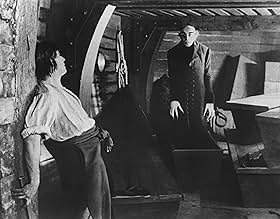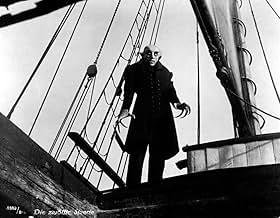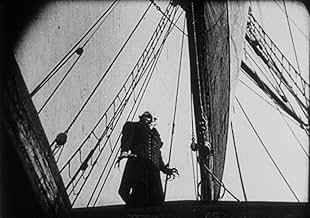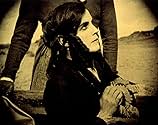El vampiro conde Orlok manifiesta su interés por una nueva residencia y por la esposa del agente inmobiliario Hutter.El vampiro conde Orlok manifiesta su interés por una nueva residencia y por la esposa del agente inmobiliario Hutter.El vampiro conde Orlok manifiesta su interés por una nueva residencia y por la esposa del agente inmobiliario Hutter.
- Dirección
- Guionistas
- Elenco
- Premios
- 3 premios ganados y 2 nominaciones en total
Gustav von Wangenheim
- Hutter
- (as Gustav v. Wangenheim)
Greta Schröder
- Ellen - seine Frau
- (as Greta Schroeder)
Georg H. Schnell
- Harding - ein Reeder
- (as G.H. Schnell)
Karl Etlinger
- Kontrolleur am Kai
- (sin créditos)
Hans Lanser-Ludolff
- A magistrate
- (sin créditos)
Loni Nest
- Child at Window
- (sin créditos)
Fritz Rasp
- Knocks Mitarbeiter
- (sin créditos)
Josef Sareny
- Head Coachman
- (sin créditos)
Fanny Schreck
- Krankenschwester im Hospital
- (sin créditos)
Eric van Viele
- Matrose 2
- (sin créditos)
- Dirección
- Guionistas
- Todo el elenco y el equipo
- Producción, taquilla y más en IMDbPro
Opiniones destacadas
F.W. Murnau set the bar high for vampire movies, very high. Can not help but start praising the job Max Schreck and Murnau did to bring Count Orlok character to life on the screen. Orlok's face, hands and slender build along with his sly shuffling movements with the right camera angles and props brought a hell of a lot of general creepiness. The viewers in the twenties must have been shell shocked because they didn't tame it down which they most often did in this time period. For a full length silent feature film I found the time going fairly fast with a view dragged out scenes, that can be expected. The big bugaboo I have with Nosferatu though is the questionable ending being terribly anticlimactic. Regardless of the disappointing ending, Nosferatu is a killer film that is a must watch for horror or classic movie fans.
F.W. Murnau directs this unauthorized version of Bram Stoker's novel, Dracula. NOSFERATU is arguably the earliest surviving screen version depicting the 'Prince of Darkness'. This German production deviates slightly from the original, but the now familiar story we all know by heart is intact. Count Dracula becomes Count Orlok and journeys to Bremen, Germany instead of London. His physical appearance is not dashing, mesmerizing or even mystical; but much resembles the rats that frequently accompany him. I find this the most eerie of all that would follow. The accompanying organ music background makes this scratchy black and white silent film an essential masterpiece. Max Schreck is immortal as Nosferatu/Count Orlok.
As I'm sure it is the case for many cinema fans, my respect and admiration towards this production widely excels the enjoyment I had while watching it. "Nosferatu" is a milestone from every possible viewpoint and it's one of those very few movies I think everybody should view at least once (although it actually requires repeated viewings
) It is the very first version of Bram Stoker's legendary vampire tale and easily the most copied film in the history of cinema. I'm sure everyone is familiar with the story of young estate agent Jonathan Harker traveling to Transylvania where he acquaintances the eccentric count who feeds on blood and controls the ones he has bitten, but THIS is the original version. Shot by F.W. Murnau (who also made the equally essential titles "Faust" and "Der Januskopf") and made unforgettable by Max Schreck in his performance as the Count. And, even though this film is over 80 years old, Schreck's image is still as nightmarish as it can be. No visual or make-up effect could ever surpass the simple appearance of Max Schreck! The fact that this film is still very powerful therefore almost entirely depends on his unworldly character. "Nosferatu" is beautiful poetry, difficult to watch at times, but very rewarding. The sexual undertones as well as the shock-aspects have surely dated by now, but they're still present, and as I mentioned before they only increase my respect for Murnau and his crew. A definite must see, just make sure you're in the right mood.
I despise most vampire stories. Not even Florence Stoker's dear departed husband could keep me occupied after the first act in Transylvania in "Dracula". The vampire has been so romanticized as an archetype (particularly during the '90s) that I can't but feel that most horror fans have forgotten exactly what made us afraid of these guys to begin with. Murnau's "Nosferatu" is just such a reminder and, because of that, is the only screen version of "Dracula" that I have ever loved.
Though Murnau, in the hopes of dodging the copyright bullet, took many liberties with the novel, he actually shot a great part of the film on location (an unusual practice for the time) in the historical Dracula's old stomping grounds: the Carpathian Mountains in Romania. The town, landscapes, and castles were all for real, not just some fancy studio backdrop. To me, it helps convey the tone of authenticity, as you can believe this story being told. As for Max Schreck, no charming, suave seducer is he. With his bald head, bushy eyebrows, rat-like teeth, pointed ears, nails as long as the fingers they are attached to, emaciated build, and stare that seems to come from the bottom of Hell itself, he is the primal, archetypal image of the vampire of legend.
While some could interpret this tale as a subtext to Nazism or anti-Semetism, at it's core, it's simply the tale of a monster, who brings ruin and death in his wake. That such a tale has managed to survive it's era, considering the obstacles that could have totally removed it from view, is the gain of all who have seen. Eat your heart out, Bela Lugosi.
Though Murnau, in the hopes of dodging the copyright bullet, took many liberties with the novel, he actually shot a great part of the film on location (an unusual practice for the time) in the historical Dracula's old stomping grounds: the Carpathian Mountains in Romania. The town, landscapes, and castles were all for real, not just some fancy studio backdrop. To me, it helps convey the tone of authenticity, as you can believe this story being told. As for Max Schreck, no charming, suave seducer is he. With his bald head, bushy eyebrows, rat-like teeth, pointed ears, nails as long as the fingers they are attached to, emaciated build, and stare that seems to come from the bottom of Hell itself, he is the primal, archetypal image of the vampire of legend.
While some could interpret this tale as a subtext to Nazism or anti-Semetism, at it's core, it's simply the tale of a monster, who brings ruin and death in his wake. That such a tale has managed to survive it's era, considering the obstacles that could have totally removed it from view, is the gain of all who have seen. Eat your heart out, Bela Lugosi.
Quite possibly my own very favourite movie. No vampire film before or since has been either as disturbing or as artful. Less overtly "expressionistic" than some of the other German films of the day, but no less visually impressive. Look at the seascape where Ellen/Nina/Mina pines over her departed husband. Watch those marvelous shadows, which we see in Bremen more often than the vampire itself, used especially effectively in the closing sequence.
And look at Max Schreck himself! While Bram Stoker gave his Count affinity with wolves and bats, Murnau favours that rat, both in that they surround him and that he physically resembles a shaved, cadaverous rat. Spreading his pestilence, Max Schreck is truly the vilest, most loathsome villain in the history of film. The scene where he rises suddenly erect from his coffin aboard ship is one that horror directors everywhere should study very carefully.
Nosferatu is also noteworthy as the origin of the idea that vampires are killed by sunlight, previously present neither in literature nor folklore. In response to the poster who complained that the vampire seems to be walking around in light before his death, these scenes are set at night. In the original versions, there was a blue tint over these scenes to let you tell night from day; it's difficult to tell the difference without them.
My copy is marred with some hilarious inappropriate sound effects (such as a massive "BOING" when the gates of the castle open on their own accord) which I've learned not to hold against the film itself.
Thank God that Florence Stoker did not manage to completely wipe this film of the face of existence.
And look at Max Schreck himself! While Bram Stoker gave his Count affinity with wolves and bats, Murnau favours that rat, both in that they surround him and that he physically resembles a shaved, cadaverous rat. Spreading his pestilence, Max Schreck is truly the vilest, most loathsome villain in the history of film. The scene where he rises suddenly erect from his coffin aboard ship is one that horror directors everywhere should study very carefully.
Nosferatu is also noteworthy as the origin of the idea that vampires are killed by sunlight, previously present neither in literature nor folklore. In response to the poster who complained that the vampire seems to be walking around in light before his death, these scenes are set at night. In the original versions, there was a blue tint over these scenes to let you tell night from day; it's difficult to tell the difference without them.
My copy is marred with some hilarious inappropriate sound effects (such as a massive "BOING" when the gates of the castle open on their own accord) which I've learned not to hold against the film itself.
Thank God that Florence Stoker did not manage to completely wipe this film of the face of existence.
¿Sabías que…?
- TriviaThe movie was banned in Sweden due to excessive horror. The ban was finally lifted in 1972.
- Errores(at around 30 mins) When Hutter is writing his letter to Ellen in Count Orlok's castle, the paper that he is meant to be writing on is clearly blank throughout the scene.
- Citas
Graf Orlok: Your wife has such a beautiful neck...
- Versiones alternativasThere are a confusing number of different surviving prints, restorations and alternate versions of Nosferatu. In the main, there are three 'complete' restorations and two incomplete, partially-restored versions. All five are available on DVD, while the latest two restorations, from 1995 and 2006, are also on Blu-ray. In addition there are countless low-quality public domain DVDs with different lengths, running speeds and soundtracks. All are derived from a single print held by the Museum of Modern Art (MoMA). They usually have replacement American intertitles and are always in black and white; the film was originally color tinted throughout and only meant to be seen that way. This comprehensive article explains all of them simply and clearly: Nosferatu: The Ultimate Blu-ray and DVD Guide.
- ConexionesEdited into Boo (1932)
- Bandas sonorasJeux d'enfants - Galop
Written by Jack Norworth
[Plays during the croquet scene in the 2006 restoration]
Selecciones populares
Inicia sesión para calificar y agrega a la lista de videos para obtener recomendaciones personalizadas
Detalles
- Fecha de lanzamiento
- País de origen
- Sitio oficial
- Idiomas
- También se conoce como
- Nosferatu: A Symphony of Horror
- Locaciones de filmación
- Starhrad Castle, Nezbudská Lúcka, Slovakia(castle in ruins)
- Productoras
- Ver más créditos de la compañía en IMDbPro
Taquilla
- Total a nivel mundial
- USD 48,892
- Tiempo de ejecución1 hora 34 minutos
- Mezcla de sonido
- Relación de aspecto
- 1.33 : 1
Contribuir a esta página
Sugiere una edición o agrega el contenido que falta

Principales brechas de datos
What is the Japanese language plot outline for Nosferatu (1922)?
Responda



























